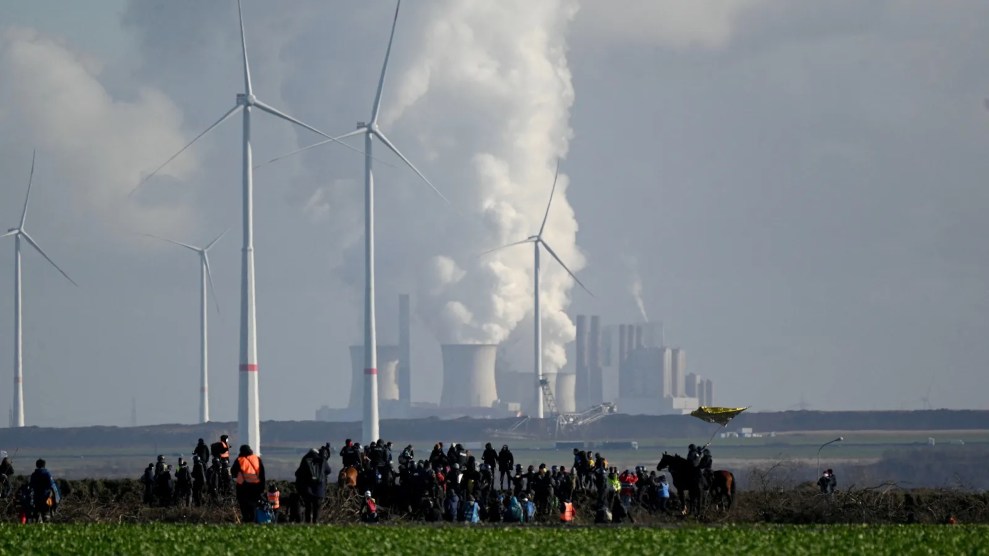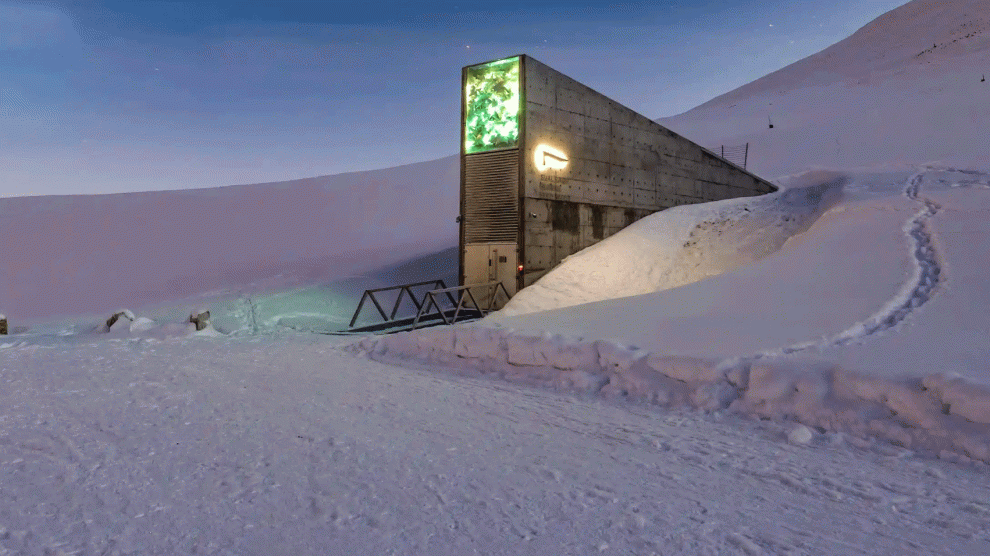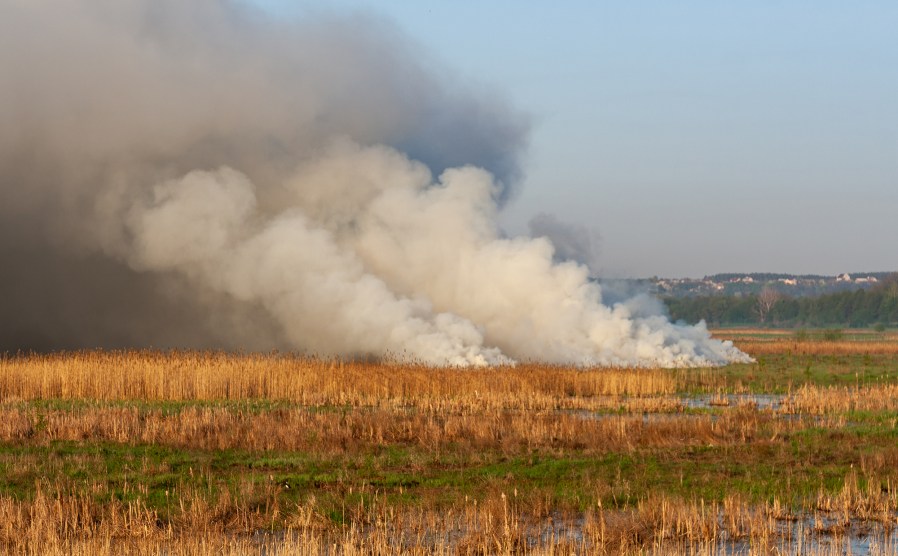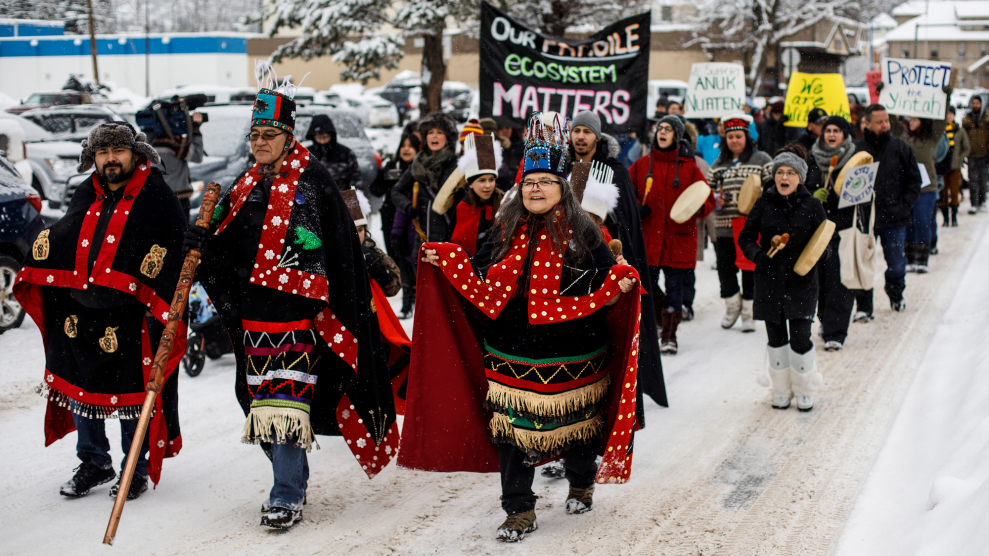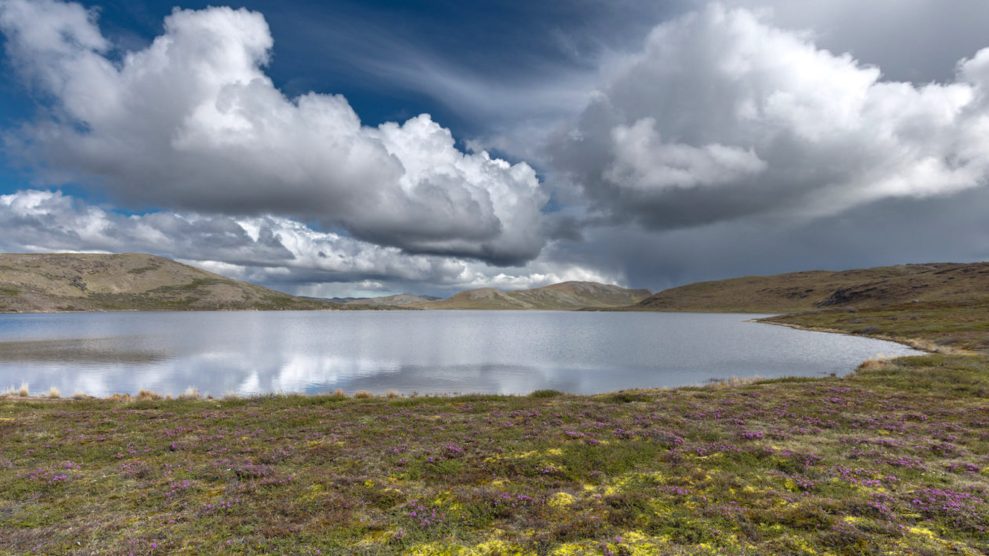
Rhododendrons and wildflowers along a tundra lake in West Greenland.Mariusz Potocki/Yale e360
This story was originally published by Yale e360 and is reproduced here as part of the Climate Desk collaboration.
A family of muskox rumbles along craggy hilltops overlooking the small parade of humans crossing the West Greenland tundra. Ecologist Václava Hazuková, in the lead, sets a brisk pace as we bushwhack through knee-high willow and birch. Leaning forward under an equipment-filled pack nearly half her size, she high-steps over “pillows and mattresses”—hummocks of plants interspersed with troughs of rain-soaked permafrost. The twin blades of a kayak paddle protrude from Hazuková’s pack, pointing to our destination: Lake SS85, a small, clover-shaped lake some two hours away.
Lake SS85 is one of hundreds of lakes dotting this 90-mile-wide fringe of land between the towering Greenland Ice Sheet and the Labrador Sea. For centuries, 85 and its aquatic neighbors have been ice-covered most of the year. But as the climate has warmed, high-latitude lakes—from the northern United States and Canada to Scandinavia and Siberia—have started to thaw, on average, a week earlier and freeze 11 days later than they did a century ago, according to Sapna Sharma, a biologist at York University in Toronto. The rate of ice loss has sextupled over the past 25 years. Northern lake temperatures are rising more than twice as fast as the global lake average, Sharma says. And nowhere is the climate changing faster than in the Arctic.
The boreal forests and unglaciated polar lowlands are Earth’s most lake-rich biome, hosting nearly half of the planet’s lakes by surface area. While precise data are sparse, a 2015 satellite-based inventory estimates some 3.5 million lakes cover a total of around 150,000 square miles in the Arctic. But due to the difficulty of conducting research in the remote north, relatively little is known about how these vast freshwater ecosystems are responding to the sweeping changes underway.
One of scientists’ key questions is how rising temperatures, shrinking ice seasons, and the increasing precipitation projected for many parts of the Arctic might affect lakes’ carbon cycles. Put simply, this cycle describes the actions of aquatic microbes that break down organic material—exhaling carbon dioxide and other greenhouse gases—and phytoplankton that take up carbon dioxide to build their skeletons—releasing oxygen. Lakes that breathe out more carbon dioxide than they take in are net carbon sources, while those that on balance remove carbon dioxide from the atmosphere are sinks.
In the frozen north, lakes have, over millennia, locked up huge stores of carbon in their sediments. But are changing Arctic conditions shifting sinks to sources, unleashing emissions that will accelerate climate change? That’s what Hazuková, a PhD candidate in ecology at the University of Maine’s Climate Change Institute, is here to find out.

University of Maine researchers Václava Hazuková and Ansley Grider hike over tundra on their way to study lakes in West Greenland.
Mariusz Potocki/Yale e360
“We are trying to understand the carbon budget in the Arctic,” says Hazuková. The stakes are high: That ledger of sinks and sources informs the models that scientists use to project the Earth’s future climate. Currently, however, the estimate “pretty much only focuses on soils and vegetation,” she says. “Freshwaters are just not included at all.”
Some of those freshwater systems are changing “very, very quickly,” says John Smol, a paleolimnologist at Queens University in Kingston, Ontario. Earlier thaws and later freezes expose lakes to more light, heat, and contact with the outside world. The impacts compound at high latitudes, such as the lakes on Canada’s Ellesmere Island that Smol has studied for decades. The summer ice-free period up there used to be six weeks at most, he says. With 24-hour daylight during the Arctic summer, less time under ice cover opens lakes to significantly more time under the sun.
Arctic lakes are diverse, however, and climate change is manifesting differently across regions. In areas where rapidly thawing permafrost releases once-frozen stores of plants and other organic material into lakes, microbes are feasting on those extra helpings of carbon and belching out carbon dioxide and methane. Thermokarst lakes such as Alaska’s Big Trail Lake visibly boil with escaping greenhouse gases. Across the boreal region, the total annual carbon dioxide emissions from lakes is equivalent to that of forest fires, according to a study conducted in 2017 (before the recent extreme wildfire seasons).
But those amped-up emissions may be offset, at least in part, by lakes that emit little or even sponge up carbon. In a 2019 survey of Alaska’s Yukon River Basin, biogeochemist Matthew Bogard found lakes in that flat, dry region produce “negligible” CO2 emissions. That’s because those lakes have little hydrologic connection to the surrounding landscape, which means almost no organic material is delivered to the lakes through outside water flowing in, explains Bogard, who is now at the University of Lethbridge in Alberta.
Data on Arctic emissions are patchy overall, Bogard acknowledges. “We need more data from understudied regions.”
But quantifying a lake’s gas output requires on-the-ground fieldwork to place strings of sensors anchored to the lakebed, and another trip to retrieve them. That means a lot of hiking. As we stride over the tundra during my visit to Hazuková’s research site near Kangerlussuaq in July 2023, she describes her objective: to provide the first multi-season measurements of carbon dioxide emissions from lakes in this arid terrain. Like those in the Yukon River Basin, lakes in West Greenland also receive little inflow from their surroundings, and Hazuková expects they’ll be carbon sinks during the normally rainless summers. The data from West Greenland will help fill a critical information gap for similar dry landscapes, which cover some 25 percent of the Arctic lake region, she says.
Except this summer isn’t normal. Across the Northern Hemisphere, 2023 will turn out to be the hottest summer on record, according to the European Union’s Copernicus Climate Change Service. In West Greenland, we see day after day of rain. Everyone in Kangerlussuaq is talking about the extraordinary weather. Longtime resident Vivi Grønvald tells me she’s never seen a summer this wet. “It’s like we haven’t had a summer at all,” she laments. The period from May to July ends up breaking West Greenland precipitation records dating back to 1940, climatologist Sean Birkel, developer of the University of Maine’s Climate Reanalyzer, found in an August analysis. Birkel linked the season’s extreme precipitation to large circulation anomalies, including unusually weak North Atlantic winds, likely related to the 2023 El Niño.
For lake scientists, all that rain makes for murky work. Usually, these lakes are crystal clear, says project co-lead Jasmine Saros, a University of Maine ecologist who has worked in the area for more than a decade. But this year, the water is the color of coffee. “This is the first time I’ve seen these lakes like this,” Saros says. “So dark.”
The opaque water makes it nearly impossible for the team to retrieve the CO2, dissolved oxygen, and light sensors from the half-dozen lakes in which they had been deployed four months earlier. At Lake SS85, Hazuková and colleague Mariusz Potocki, a postdoctoral researcher at the University of Maine, launch a small inflatable boat they had lugged over the tundra. For the next couple of hours, they spin in circles around the coordinates where the string of instruments are supposed to be. While Potocki paddles, Hazuková holds a GPS locator in one hand and an umbrella in the other, trying to shield the lake surface so she can see into the hazy depths below. It rains. Then it hails. Then it rains again. Finally they give up.
The next day is more successful. At a picturesque lake named SS1590 (the Geological Survey of Denmark and Greenland bestowed these numbers in no apparent order), Hazuková and helpers again paddle out. Although 1590 is just as dark as 85, this time they find and retrieve all three sensors, as Saros watches from shore. The lake basin is alight with tiny fushcia-colored rhododendrons. And it’s peppered with the droppings of caribou, whose clumps of white fur flutter in willow patches where ptarmigans hide. A crenellated ice dome peeks over the mountains at the horizon.

Hazuková, in front, and University of Maine researcher Jasmine Saros take a sediment core from a lake in West Greenland.
Mariusz Potocki/Yale e360
Saros has observed some big changes as the area’s lake ecosystems respond to the shifting climate. Greenland’s mean annual air temperature has climbed 3 degrees C since late last century. Lakes abruptly began to thaw nearly a week earlier.
Now, however, “variability is increasing,” Saros says. Like a top wobbling before it drops, ice-out has vacillated between early and late in the past few years. This year was late, under unusually cloudy skies. And with all the rain flushing material in from the tundra, Saros expects the lakes’ carbon content—and CO2 output—will jump.
That becomes clear at night in the lab. After a long day of hiking, hauling, and paddling, Hazuková and Saros settle into their equipment-cluttered workspace at the National Science Foundation research station in Kangerlussuaq to examine the day’s results. “The data that we got so far from the carbon sensors shows all the lakes were carbon sources,” Hazuková says, leaning over a computer screen filled with numbers. “Between April and now, they were carbon sources the whole time.”
That’s the opposite of what the researchers expected. “The reason why we started this study is that we thought these lakes were going to be sinks of carbon, at least during the summer…because they are not receiving organic matter to fuel respiration,” Hazuková reflects. “But what we saw this year was just unprecedented.”
So unprecedented, in fact, that Hazuková and Saros return to Kangerlussuaq in August for another look. They speed-hike the same route, covering around 60 miles in a week. The West Greenland weather has returned to its usual rainless days of long summer sun. The lakes are still brown, but their carbon dioxide levels have dropped, and several are once again behaving like sinks, says Hazuková.
Of course, one unusual year doesn’t amount to a trend. And no two lakes act the same: it’s their net gain or loss that determines overall carbon budget. But these lakes’ quick response to the change in weather could offer a peek over the horizon. If, in a warmer, wetter Arctic, lakes that normally store carbon switch to exhaling it into our already overloaded atmosphere, “this is obviously going to have a positive feedback effect on the climate system,” Bogard says.
Increased lake emissions could speed Arctic landscape thaw, fueling yet more emissions and more thaw. The impacts would be felt across the globe.
“What happens in the Arctic affects all of us,” says Smol. It just starts happening there first.
